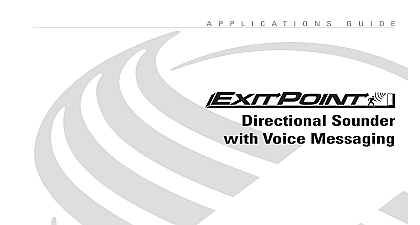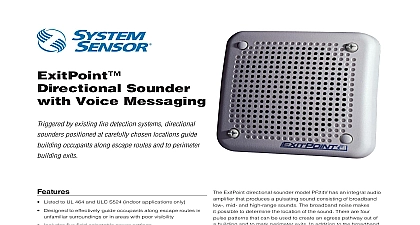System Sensor ExitPoint Directional Sounder FAQ

File Preview
Click below to download for free
Click below to download for free
File Data
| Name | system-sensor-exitpoint-directional-sounder-faq-5238460791.pdf |
|---|---|
| Type | |
| Size | 1.91 MB |
| Downloads |
Text Preview
Frequently Asked Questions Directional Sounders Voice Messaging are the limitations of traditional Exit signs most buildings exit routes are identified by visual means using exit signs in an emergency many people fail to spot nearby exits and can walk past them for a variety of reasons For example signs can be obscured smoke Exits can also be difficult to find in visually cluttered areas i e shopping malls And even if exit signs are clearly visible occupants evacuate a building by the route through which they entered Many times is not the quickest or safest way out is an ExitPoint directional sounder by existing fire detection systems ExitPoint directional sounders at carefully chosen locations guide building occupants along escape and to perimeter building exits ExitPoint has been shown to decrease times by up to 75 percent even in conditions with little to no visibility makes this sound directional uses broadband noise the only type of sound human brains can pinpoint Narrowband sounds such as emergency sirens are more to pinpoint This is why many people can locate the direction of an ambulance until they see it there any risk of leading building occupants toward an exit that safe exit signs mark the pre designated exits within a building They make attempt to indicate whether a route is safe or not The evacuee has to make his decision on which route to take When used as a simple audible exit system directional sounders are used as an aid to highlight where routes and exits are located just like emergency exit signs two or more ExitPoint sounders are heard at the same how do building occupants choose which to follow routes leading towards the ExitPoint speakers are equally visible shows occupants will choose the route where they perceive speaker to be the loudest However if there are signs that one is less viable due to smoke heat or sounds of distress they will a route that they believe offers the best chance for survival does ExitPoint voice messaging work if a building occupant is deaf does not replace traditional exit signs so these methods of occupants to exits will still be available to those with complete loss However the majority of people registered as in the U S are defined as such because they cannot hear in the frequency band containing speech As a result many who are classified as deaf disabled will be able to hear and ExitPoint broadband sound is capable of playing a recorded alert message in between sound bursts that instructs occupants of the action to take they approach an ExitPoint device including up of refuge and here This makes it possible for even those who have never before heard an ExitPoint to react quickly and confidently ExitPoint has a total of 15 single combination language choices including English English Spanish English French the public know what the ExitPoint directional means even if listener ability or ambient makes it impossible to hear voice clearly Research shows that a briefing on the meaning of the sounds is critical to ExitPoint effectiveness In some trials those who had no actually arrived at appropriate exits more quickly than those had a briefing System Sensor AVFL00700 03 12


